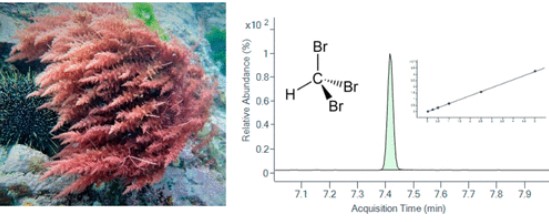Seaweed Bromoform Content Analysis Service
Reliable Bromoform Analysis Service in Seaweed at Creative Biolabs
Seaweed absorbs carbon dioxide, water, and sunlight to grow through photosynthesis, and also absorbs inorganic substances in seawater, including bromide. During the biological metabolism of seaweed, part of the bromide may be converted into organic halides, such as bromoform. This organohalogenide is usually a volatile organic compound that can accumulate in seaweed and eventually be released into the surrounding environment, and may also be passed to other marine organisms through the food chain. Bromoform is highly toxic and affects the central nervous system through inhalation and skin absorption. Due to the influence of the marine environment, harvested seaweed products may contain varying levels of bromoform. To better realize the commercialization of seaweeds, bromoform must be accurately quantified to ensure that they do not exceed safe limits. Moreover, analyzing the bromoform content in seaweed also helps monitor changes in the marine environment and pollution levels. Creative Biolabs has a reliable Seaweed Profiling platform, and our scientists provide clients with professional seaweed bromoform content analysis service through years of analysis experience.
For the detection of volatile bromoform, sample preparation is crucial. Seaweed is composed of different structures such as leaves, stems, and roots. All structures should be mixed during sampling and the moisture in fresh samples should be removed by freeze-drying. The dried seaweed samples are then crushed or cut to make them easier to mix and extract.
-
Bromoform extraction and enrichment
Methanol, hexane, pentane, and methylene chloride are commonly chosen as solvents for extracting bromoform because they are all volatile and compatible with gas chromatography (GC). We place the prepared seaweed sample and solvent in an extraction bottle to fully contact the sample with the solvent and then perform shaking extraction. The mixed solution after shaking and extraction is then centrifuged with a centrifuge to separate the upper organic phase (containing the organic matter to be measured) and the lower aqueous phase. Finally, the organic solvent in the organic phase is removed to achieve the concentration of the components to be measured.
We analyze bromoform in seaweeds by GC or gas chromatography-tandem mass spectrometry (GC-MS). We introduce the sample into the GC system. Under the conditions of the inert gas mobile phase, each component in the sample will be separated in the chromatographic column according to its boiling point and polarity and retained to varying degrees. Finally, quantitative analysis of bromoform is achieved through different detectors. A suitable detector is very important for the quantification of analytes. We have a variety of detectors for bromoform analysis, such as mass spectrometry detector (MS), electron capture detector (ECD), and flame ionization detector (FID).
In addition, some non-chromatographic quantitative methods are also used for the analysis of bromoform, such as infrared spectroscopy (IR), fluorescence spectroscopy, nuclear magnetic resonance (NMR), colorimetry, etc.

Creative Biolabs has experienced technical teams that are proficient in operating analytical instruments, extracting and separating seaweed samples, and providing clients with high-quality, reliable seaweed bromoform content analysis services to meet your needs and win trust. In addition to bromoform analysis, we also provide Sugars, Element, Fatty Acid, and Phytohormones Analysis services in seaweed. Please contact us for details if you need to inquire about a service.
Published data
Asparagopsis taxiformis (AT) in red algae is considered an effective methane inhibitor, mainly because it is rich in halogenated compounds such as bromoform (CHBr3), which can inhibit the fermentation of feed by intestinal microorganisms of ruminants, thereby reducing the production of methane gas. In this study, the authors added A. taxiformis to two different feeds and used an in vitro batch culture system to analyze the degradation pattern of CHBr3 in fermentation broth samples at different time points using a gas chromatograph. The results showed that the addition of A. taxiformis to the feed significantly reduced the production of methane. This naturally derived additive not only helped to reduce greenhouse gas emissions but also improved the feed conversion efficiency of animals.
 Fig.1 Analysis results of bromoform and dibromomethane concentrations in two feeds.1
Fig.1 Analysis results of bromoform and dibromomethane concentrations in two feeds.1
FAQ
Q1: What range of bromoform content can be detected by the method you use?
A1: Our method can generally detect bromoform content in the low to high ppm range, but the specific range may depend on the sample pretreatment method and analysis conditions.
Q2: How are the fees for your analytics services calculated? Are there any quantity discounts?
A2: The cost of analysis depends on factors such as sample quantity and sample complexity. We usually offer quantity discounts, please contact us for a quote on specific costs.
Q3: Can your analytical method be adapted to different species of seaweed?
A3: Our analysis methods are generally applicable to various types of seaweed samples, but the specific situation may vary depending on the sample characteristics, and we will make adjustments according to the actual situation.
Q4: How do you deal with possible interfering substances in your sample?
A4: We usually use appropriate pre-treatment methods or select appropriate analysis conditions to reduce or eliminate interfering substances in the sample.
Customer Review
Professional Analysis Service
"I highly recommend the seaweed bromoform content analysis services provided by the Creative Biolabs team for their professionalism and prompt service. The detailed report I received was instrumental in making informed decisions for my project."
Efficient Delivery
"The swift turnaround time of the bromoform analysis results exceeded our expectations, saving us valuable time and resources. This efficiency, coupled with the accuracy of the findings, has undoubtedly elevated our overall productivity. Thanks to the Creative Biolabs team for their hard work."
Reference
-
Romero, Pedro, et al. "Rumen microbial degradation of bromoform from red seaweed (Asparagopsis taxiformis) and the impact on rumen fermentation and methanogenic archaea." Journal of Animal Science and Biotechnology 14.1 (2023): 133. Distributed under Open Access license CC BY 4.0, without modification.
For Research Use Only.
Related Services


 Fig.1 Analysis results of bromoform and dibromomethane concentrations in two feeds.1
Fig.1 Analysis results of bromoform and dibromomethane concentrations in two feeds.1



